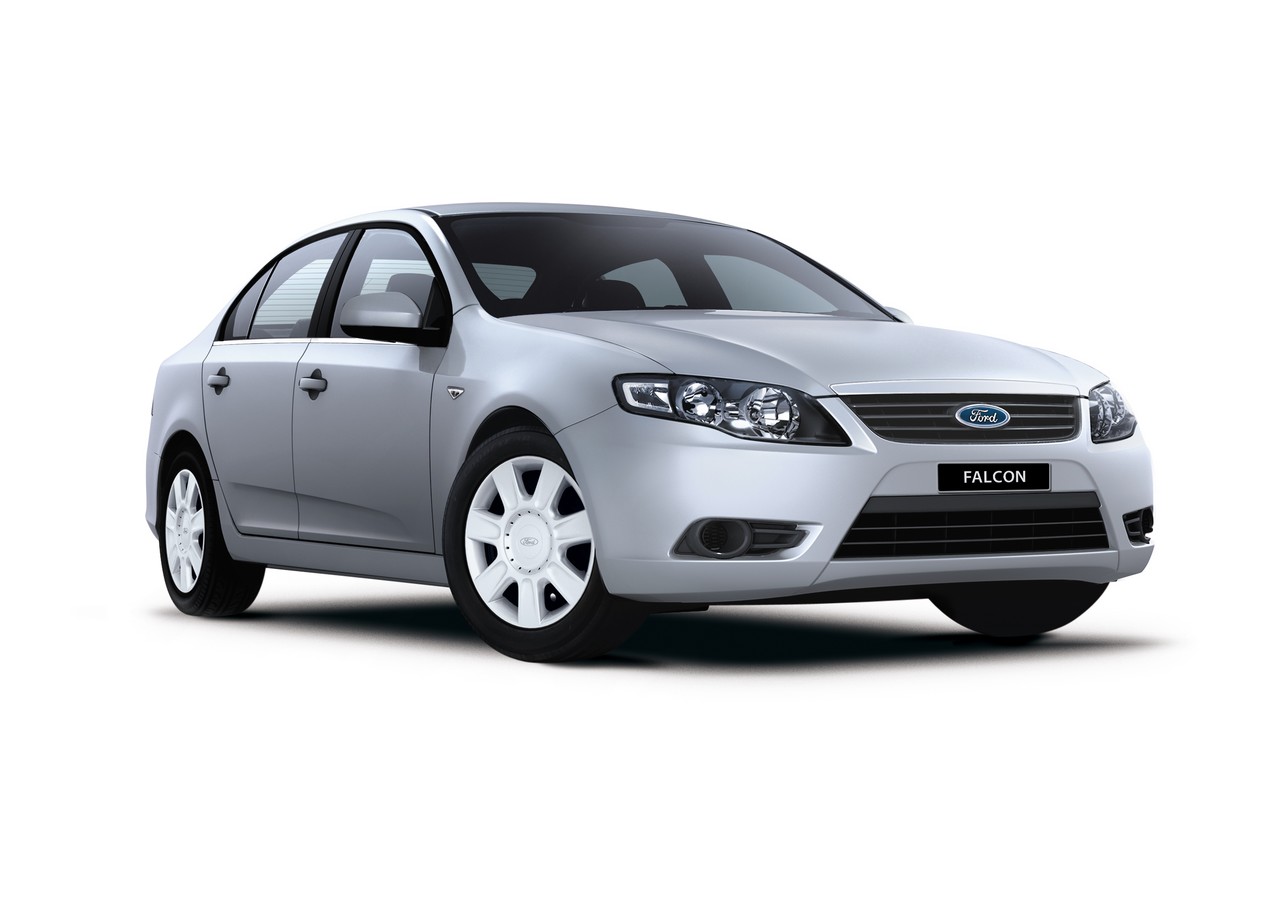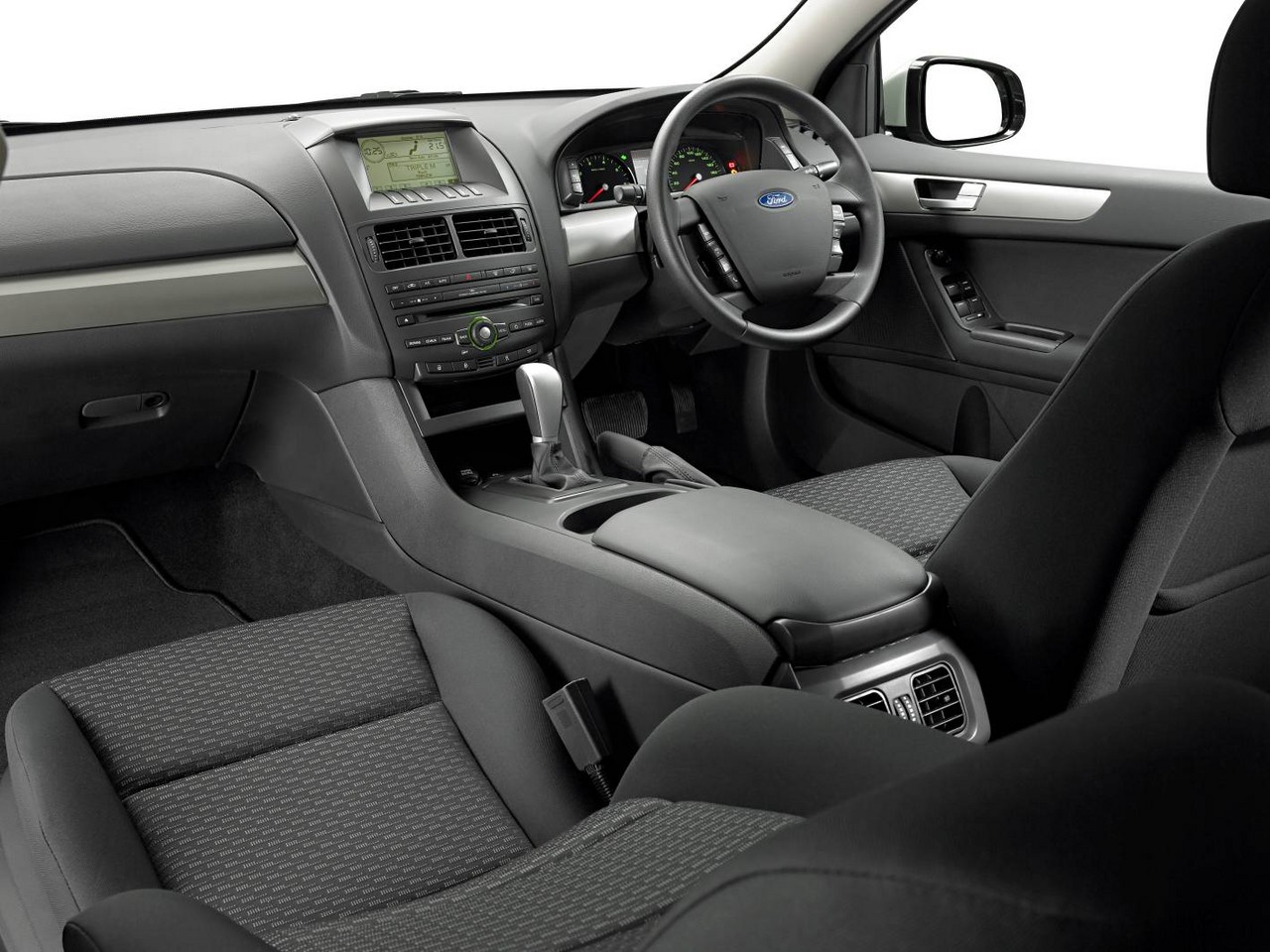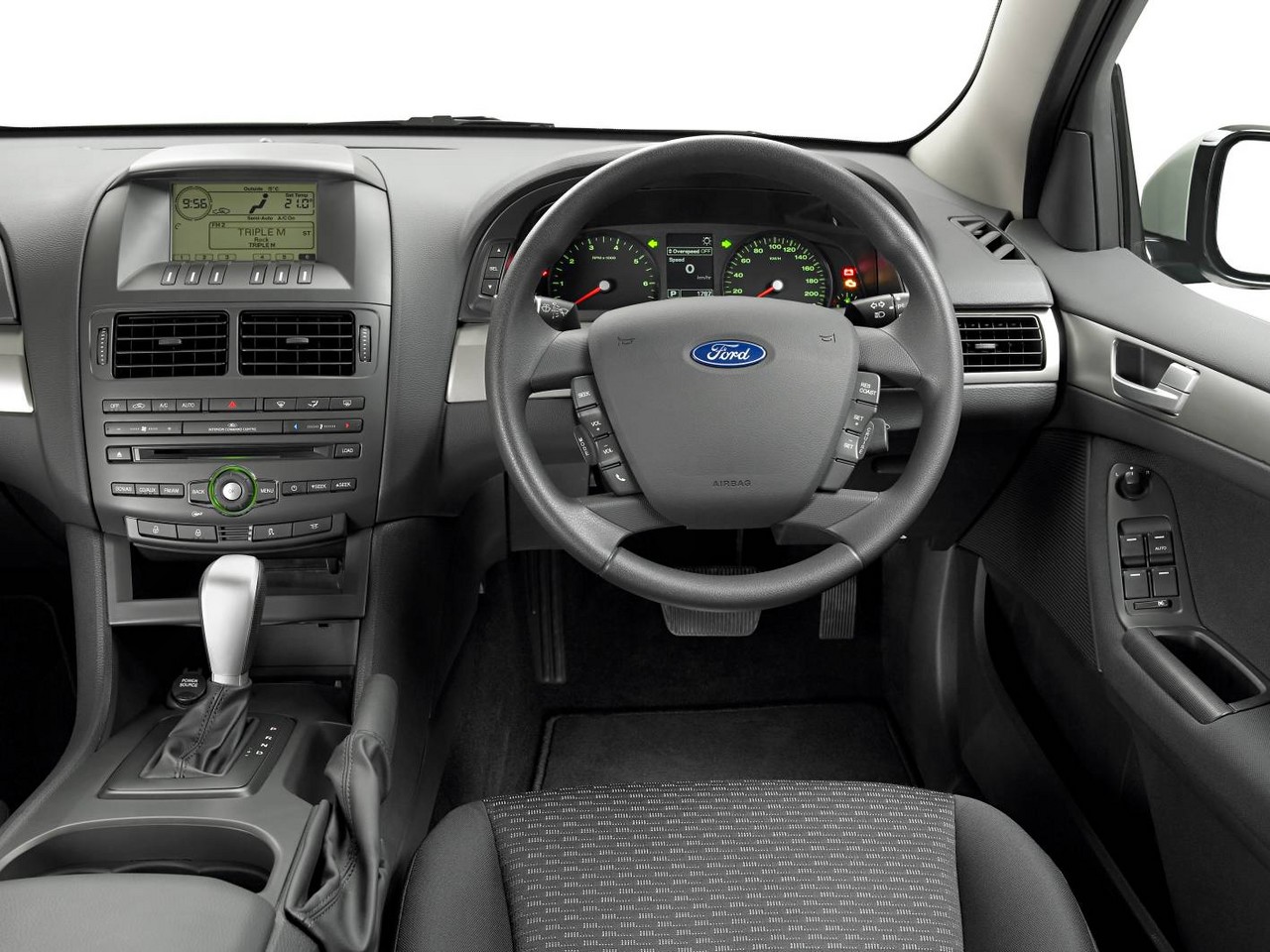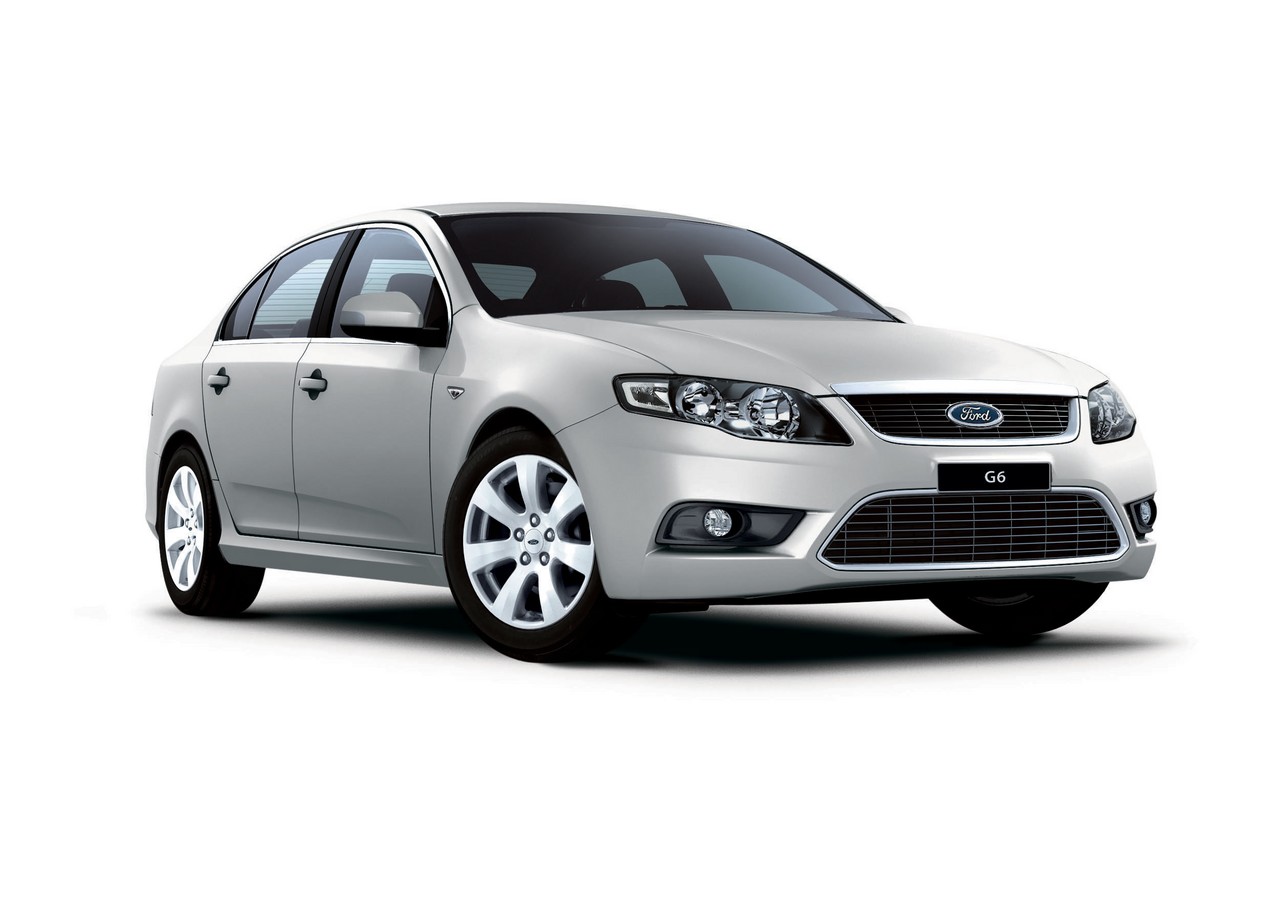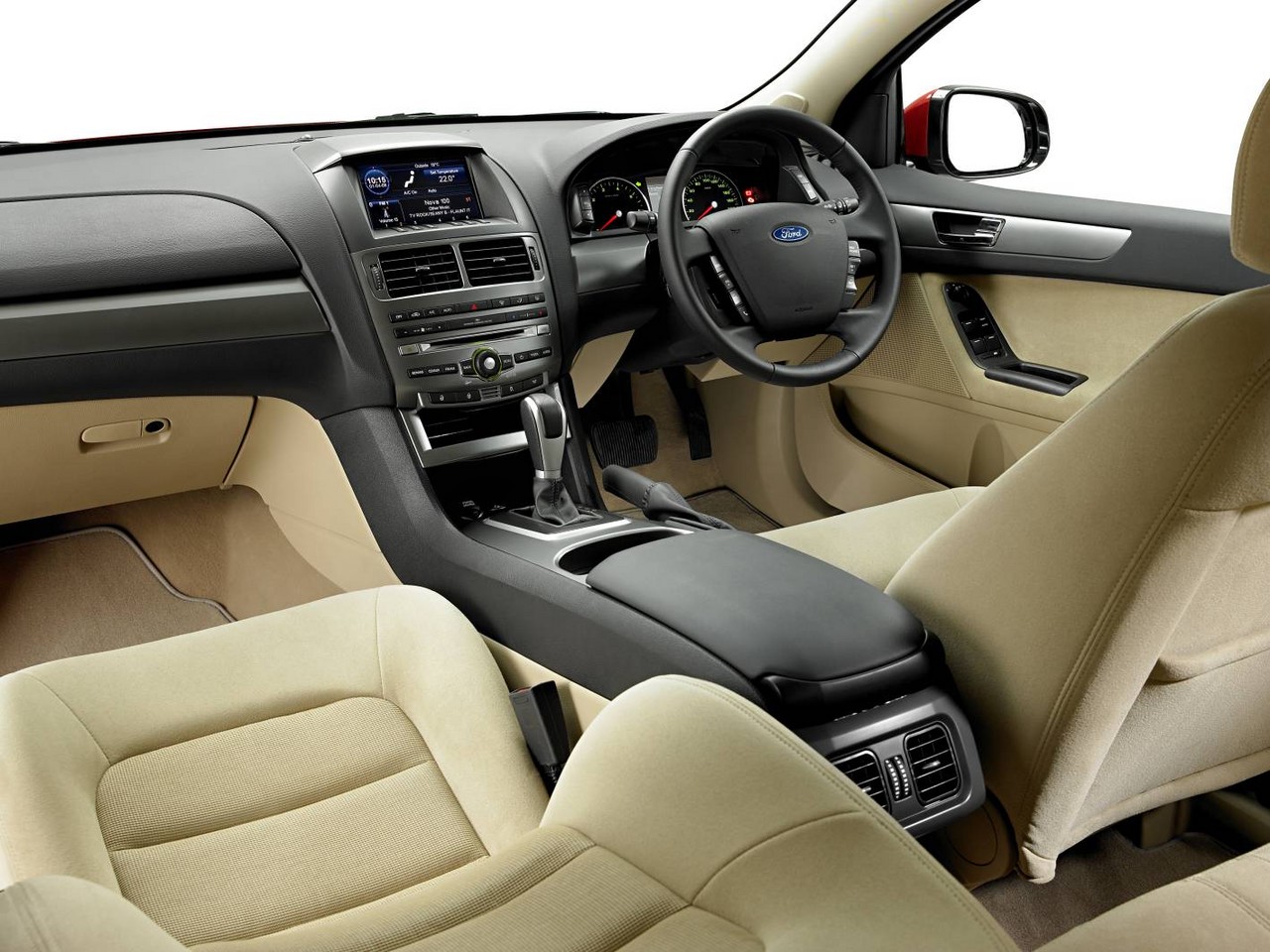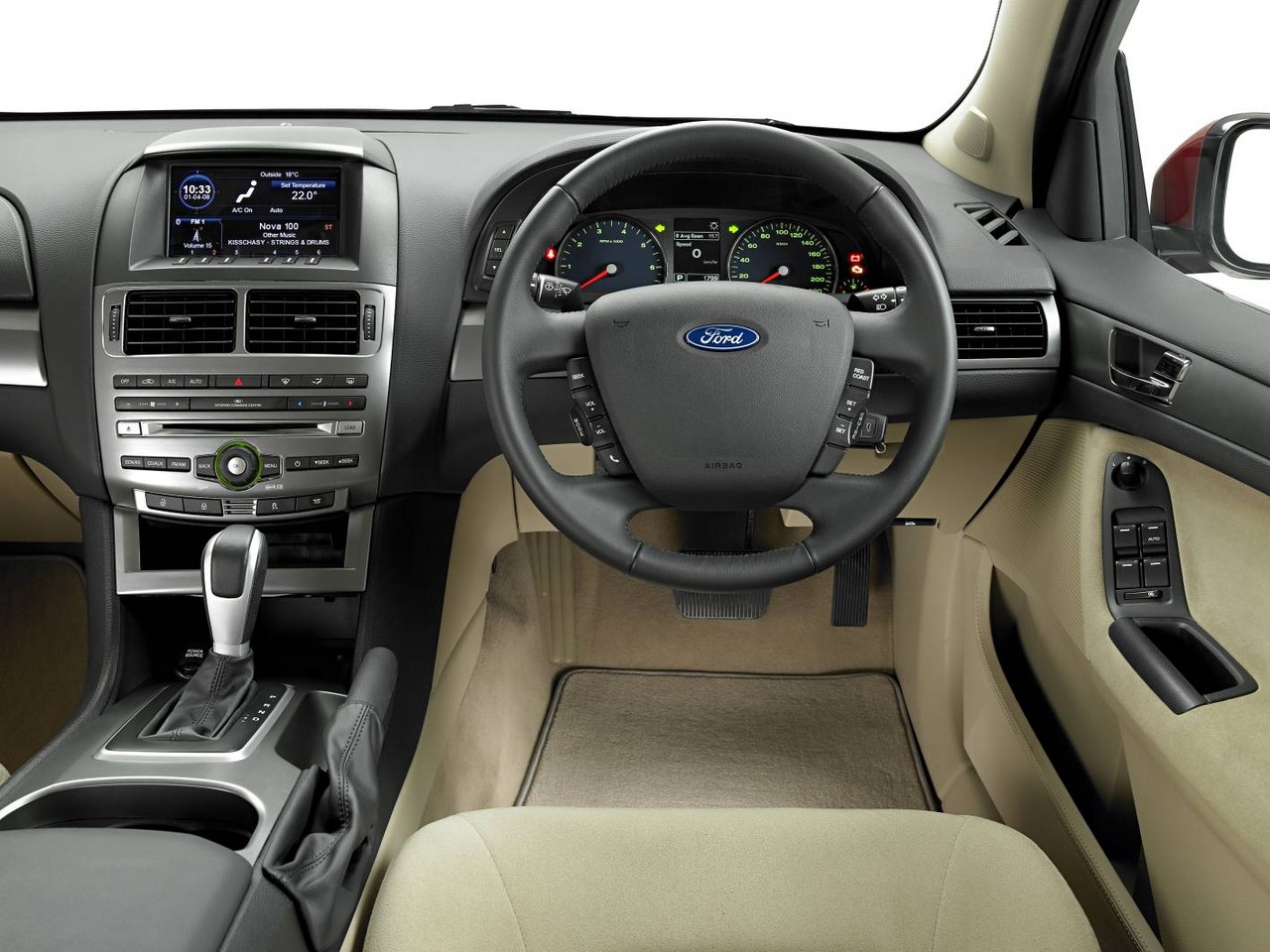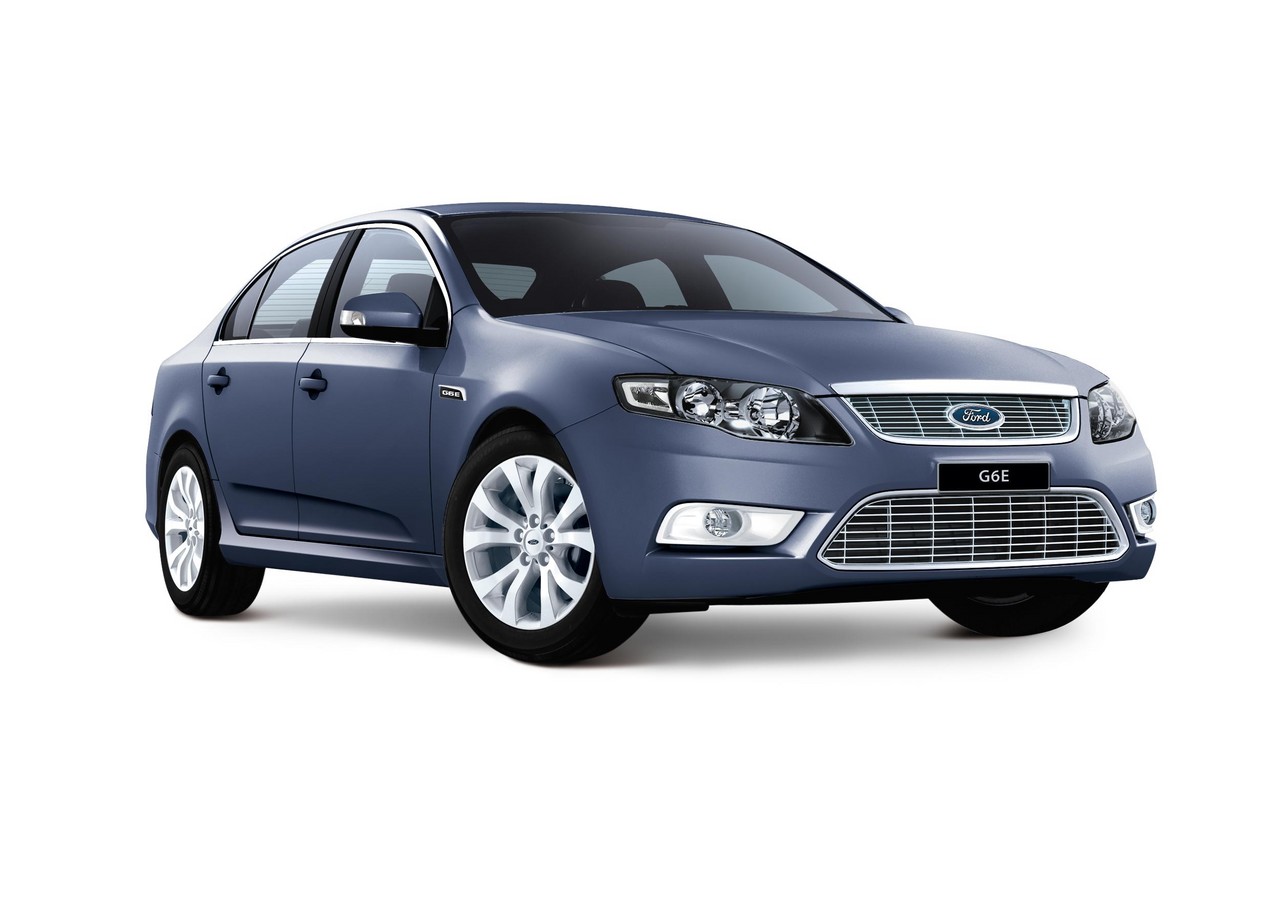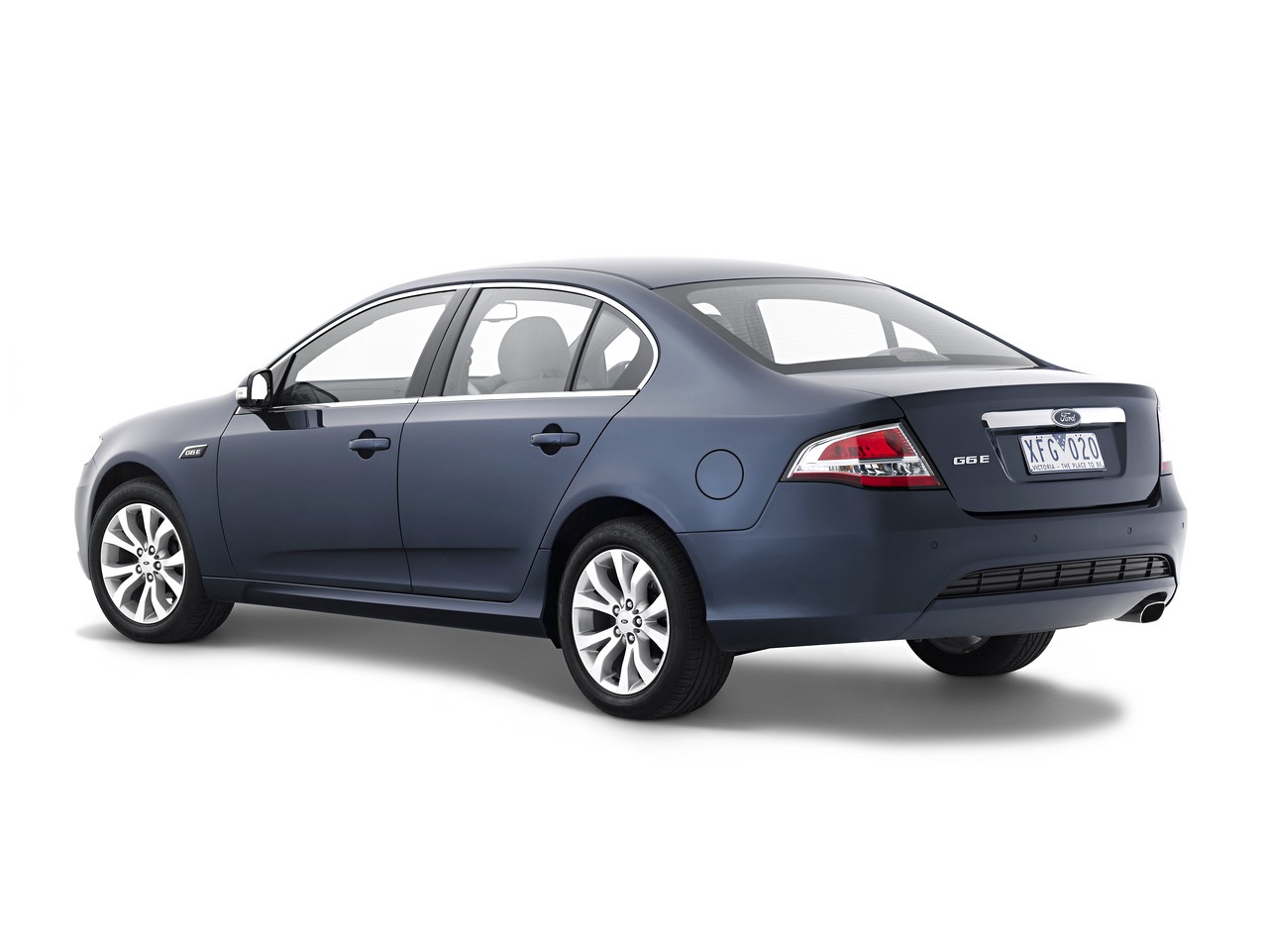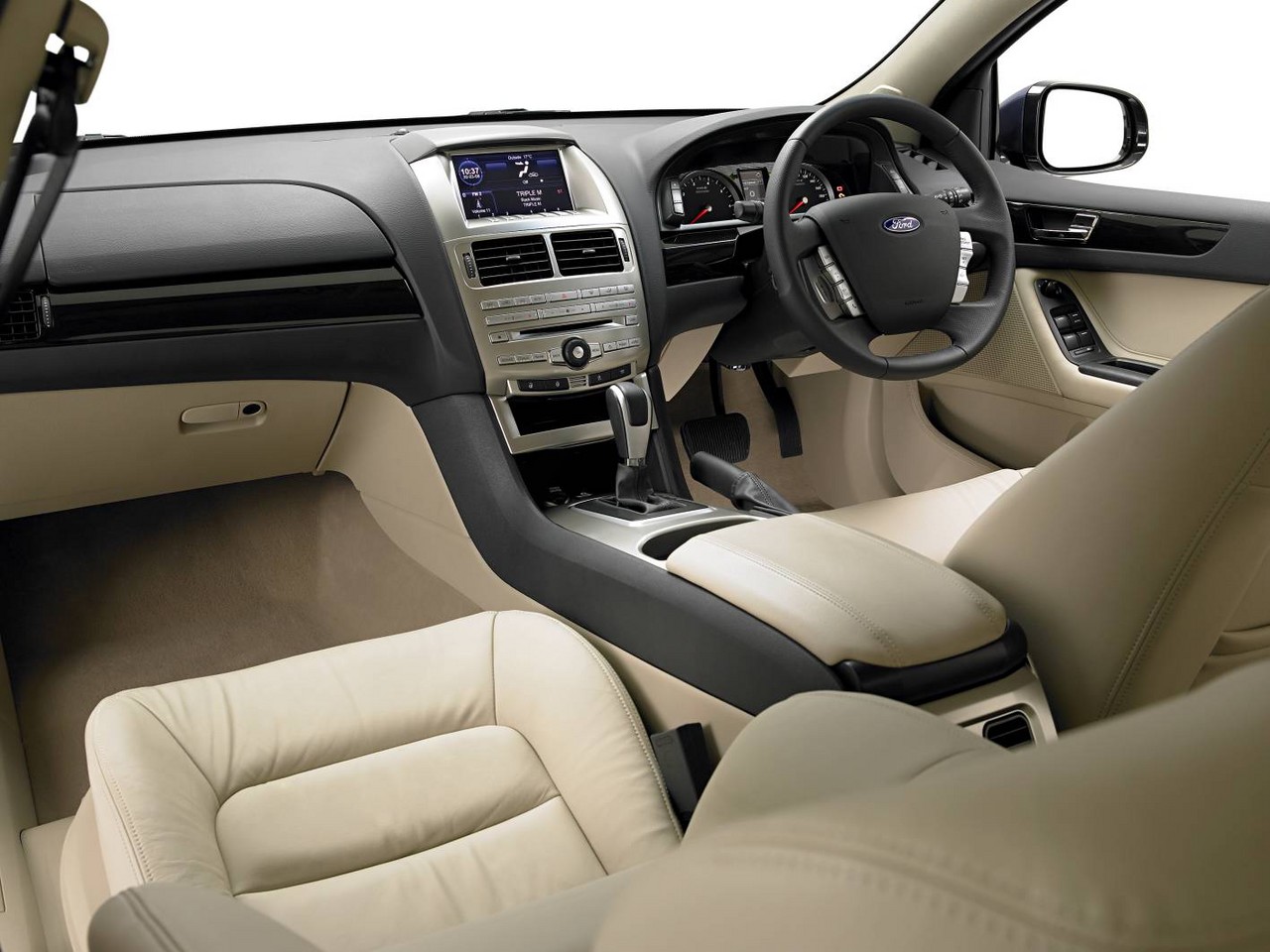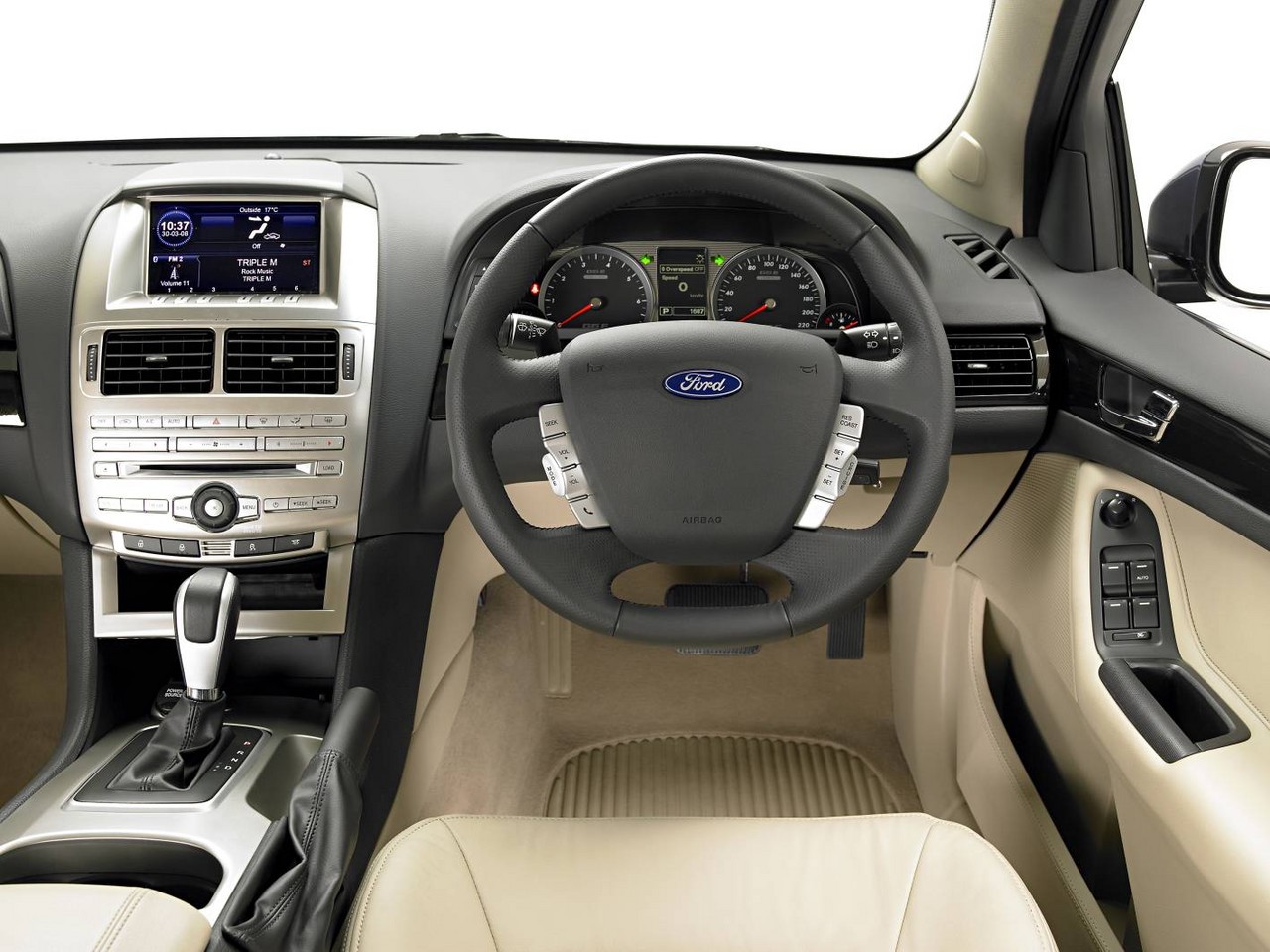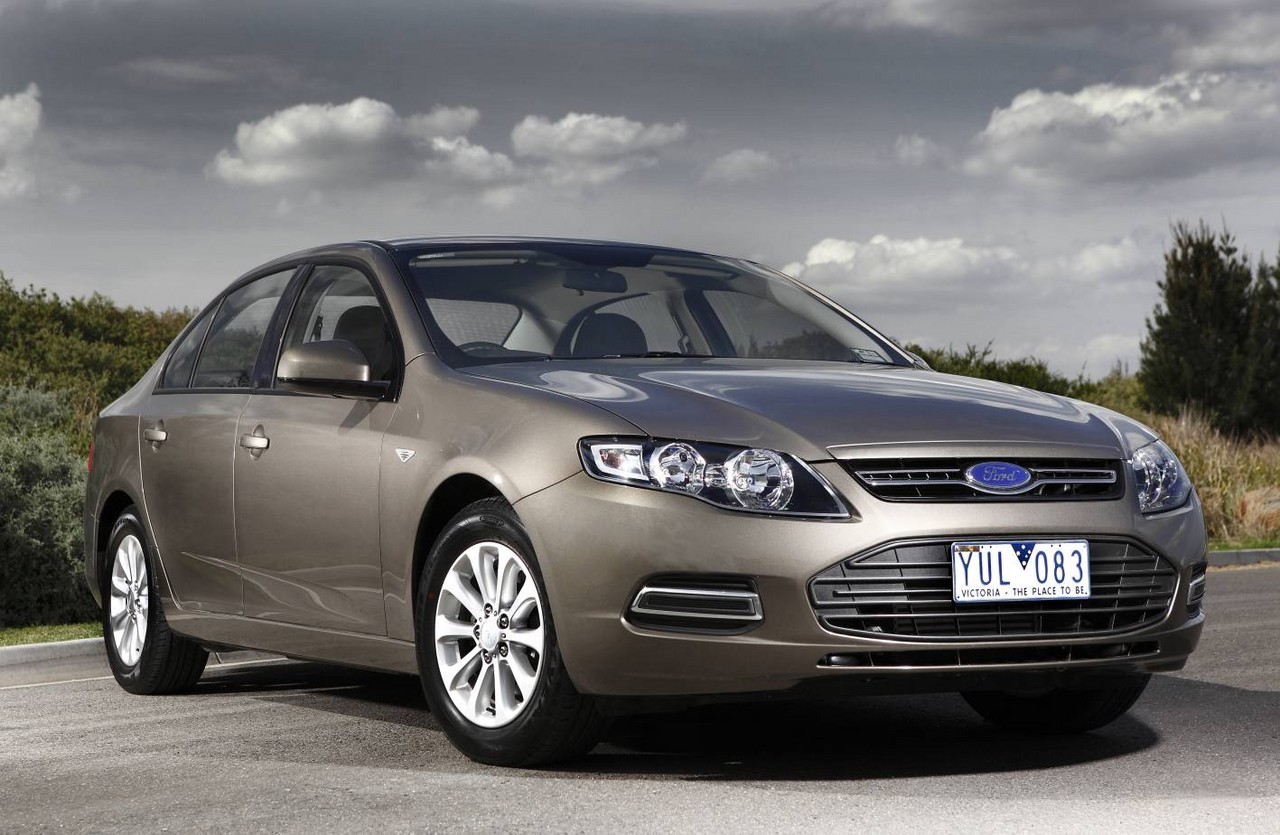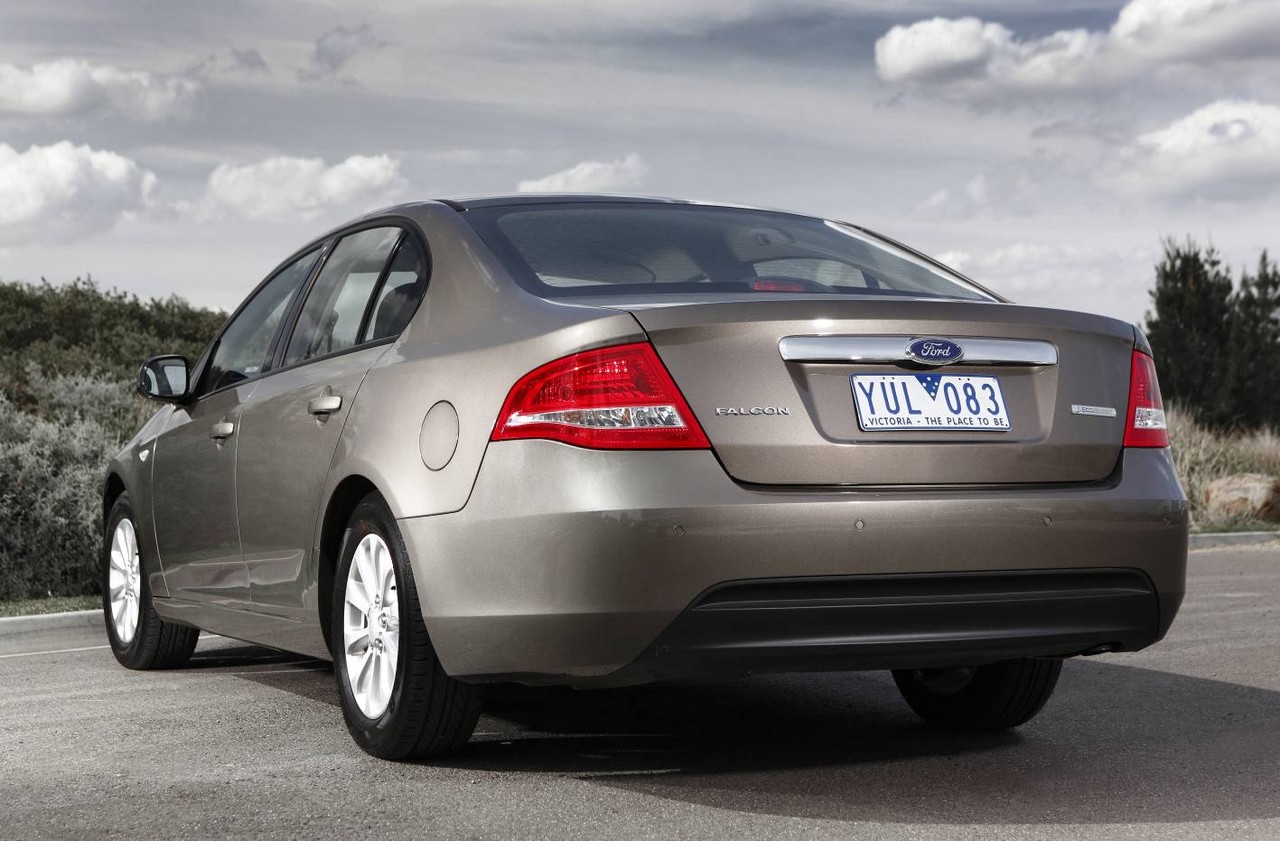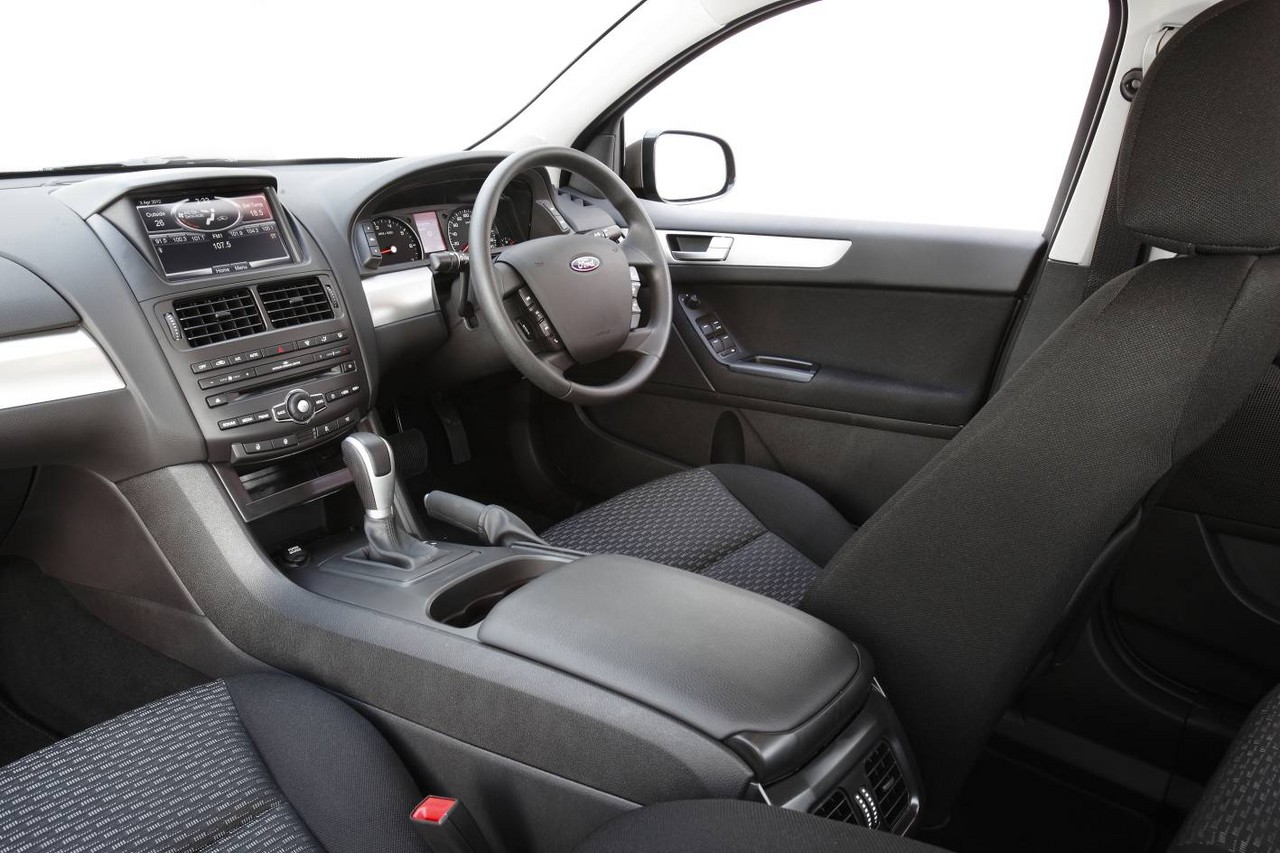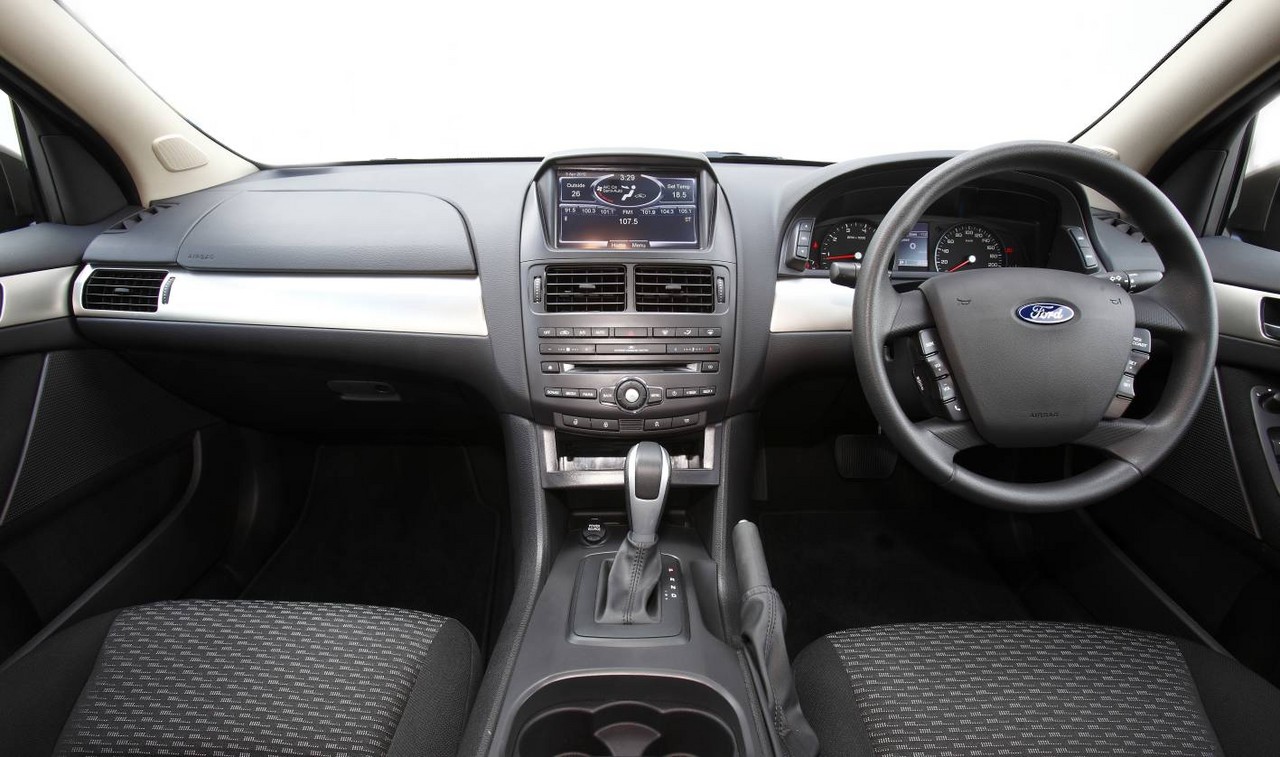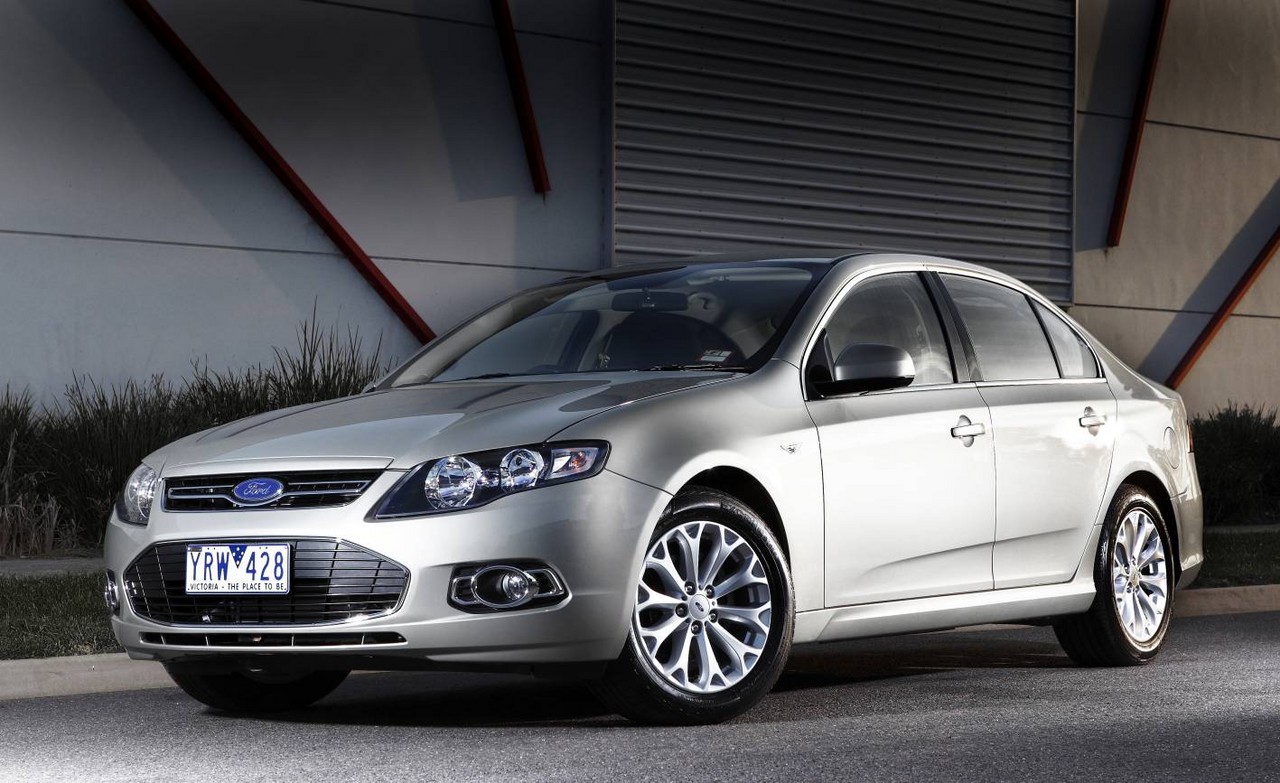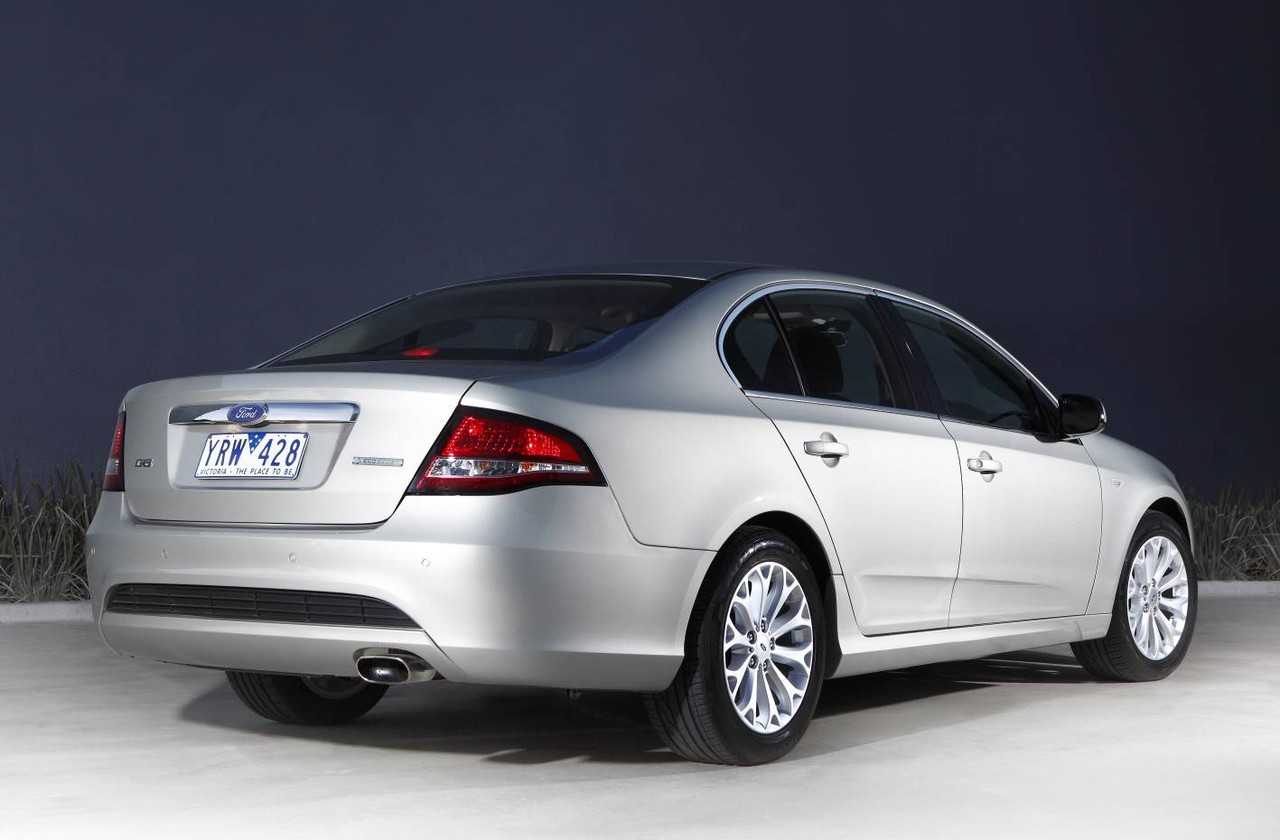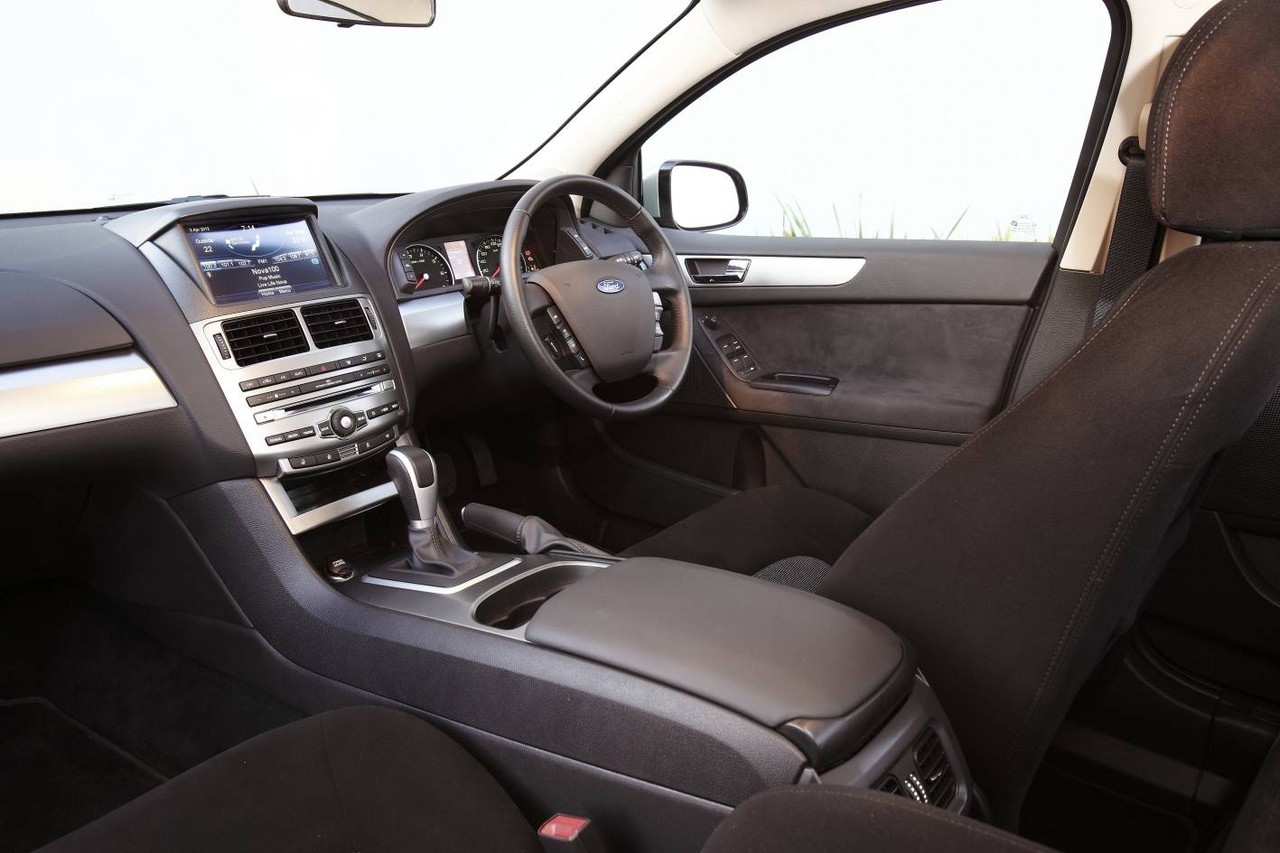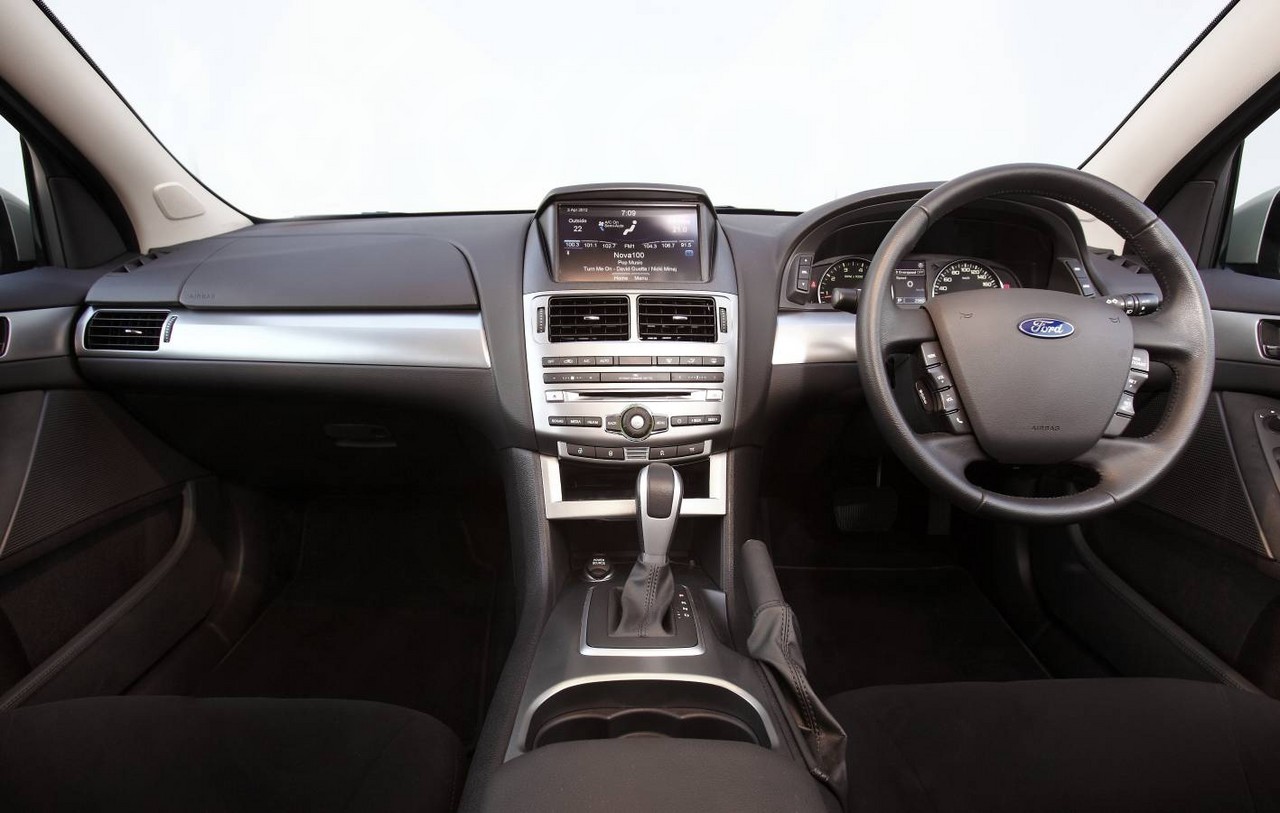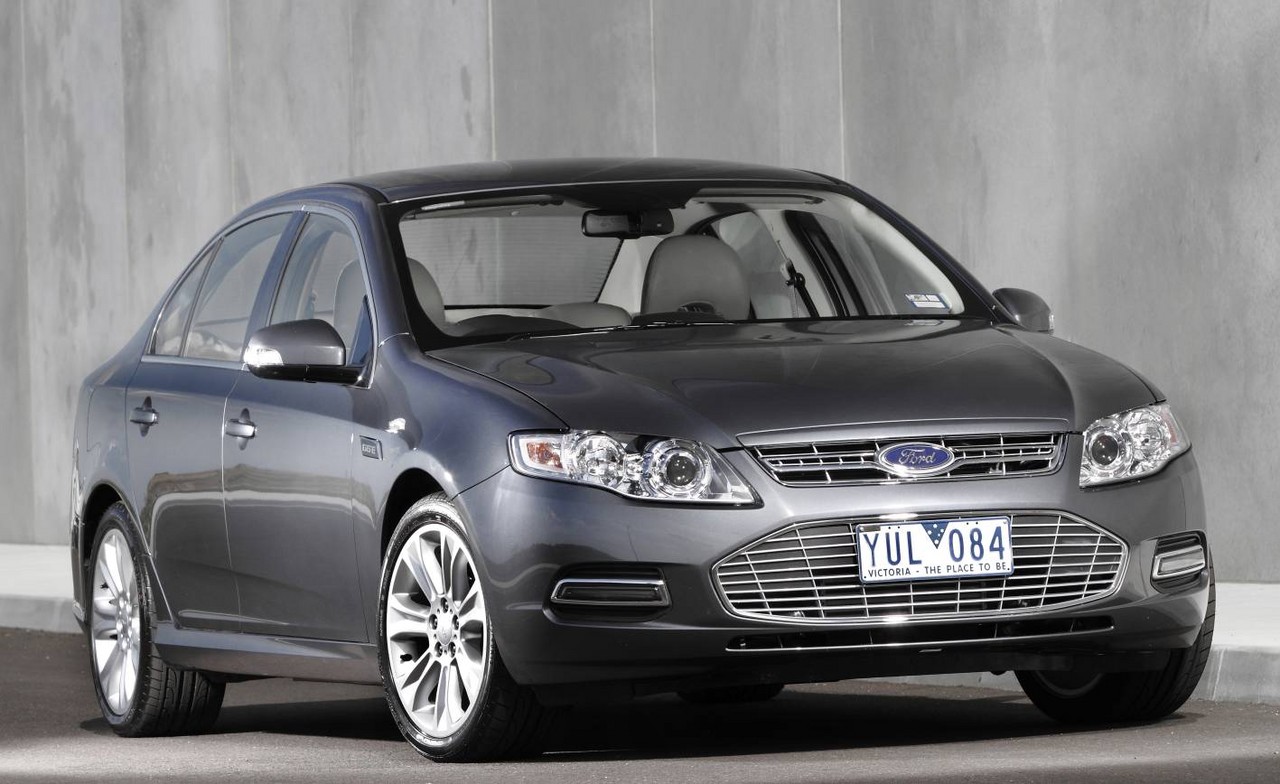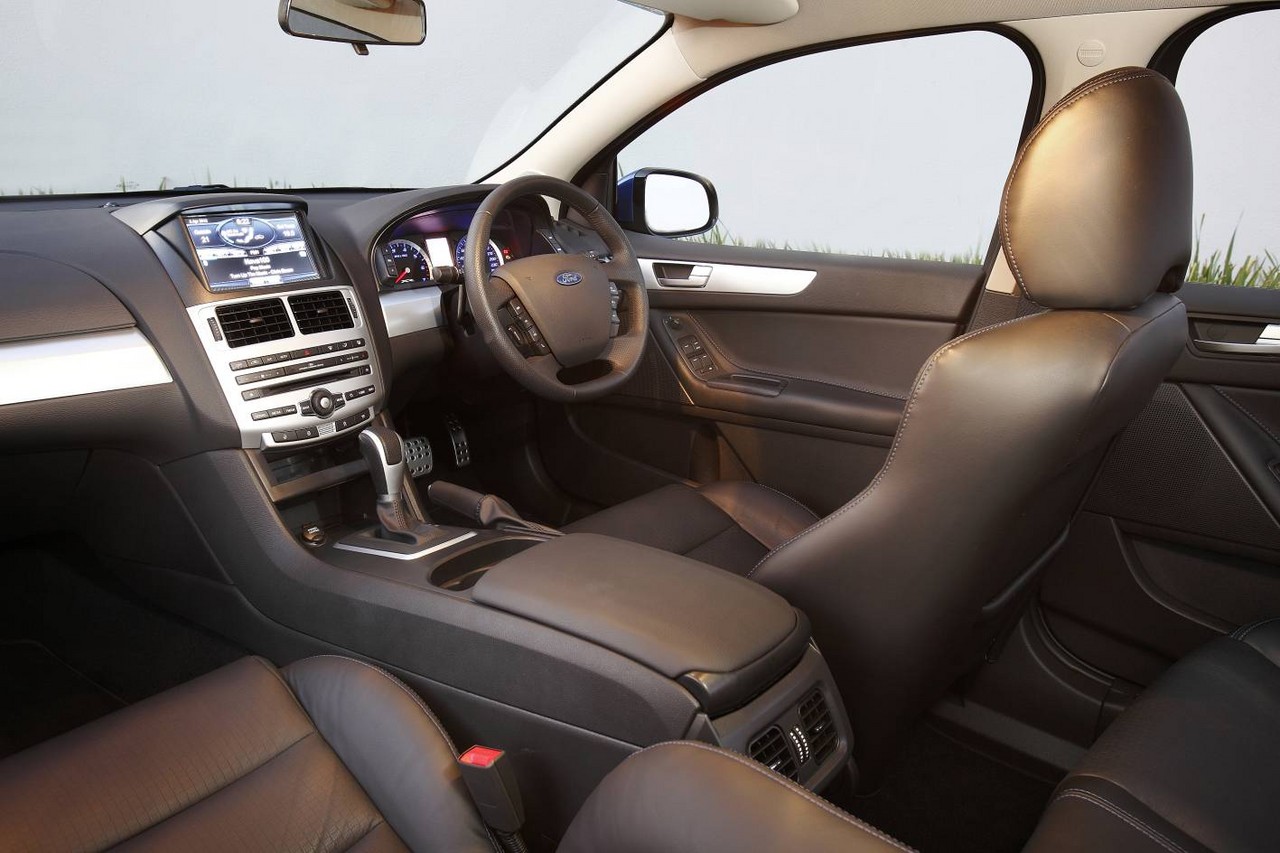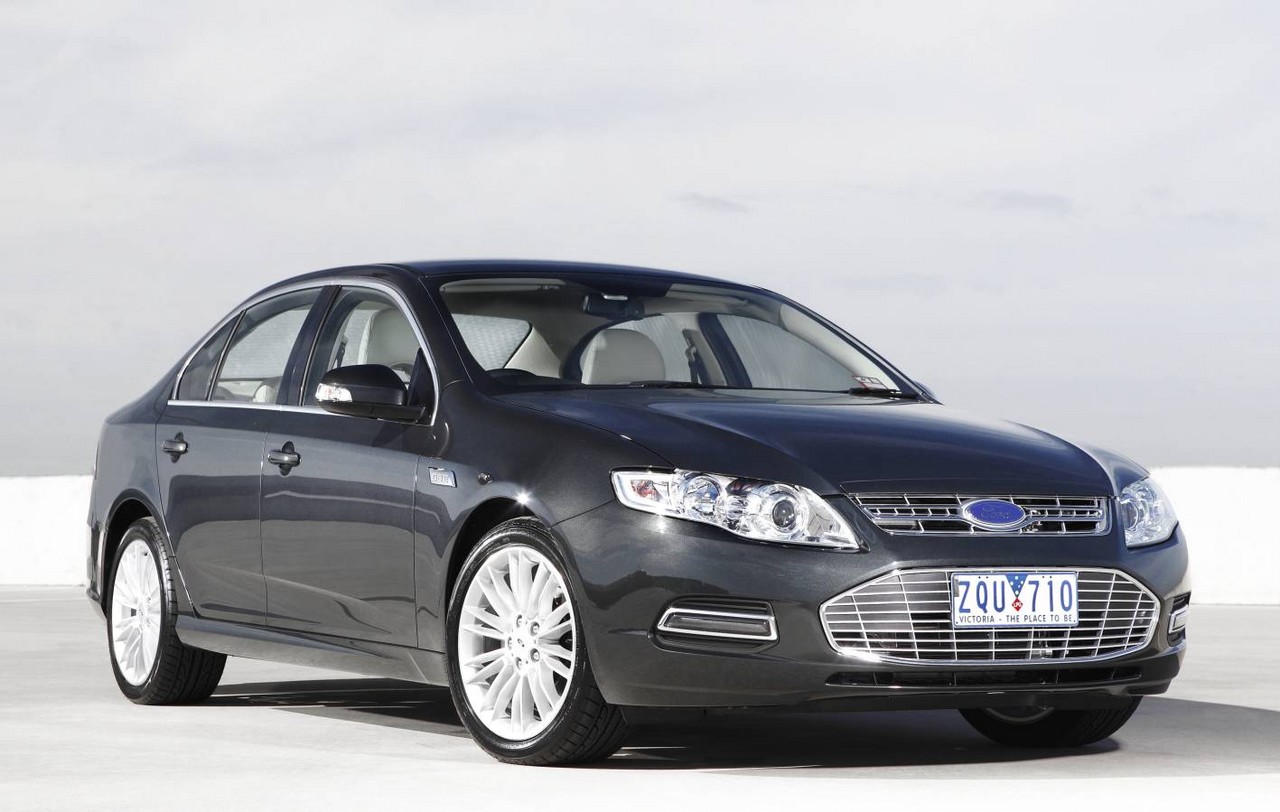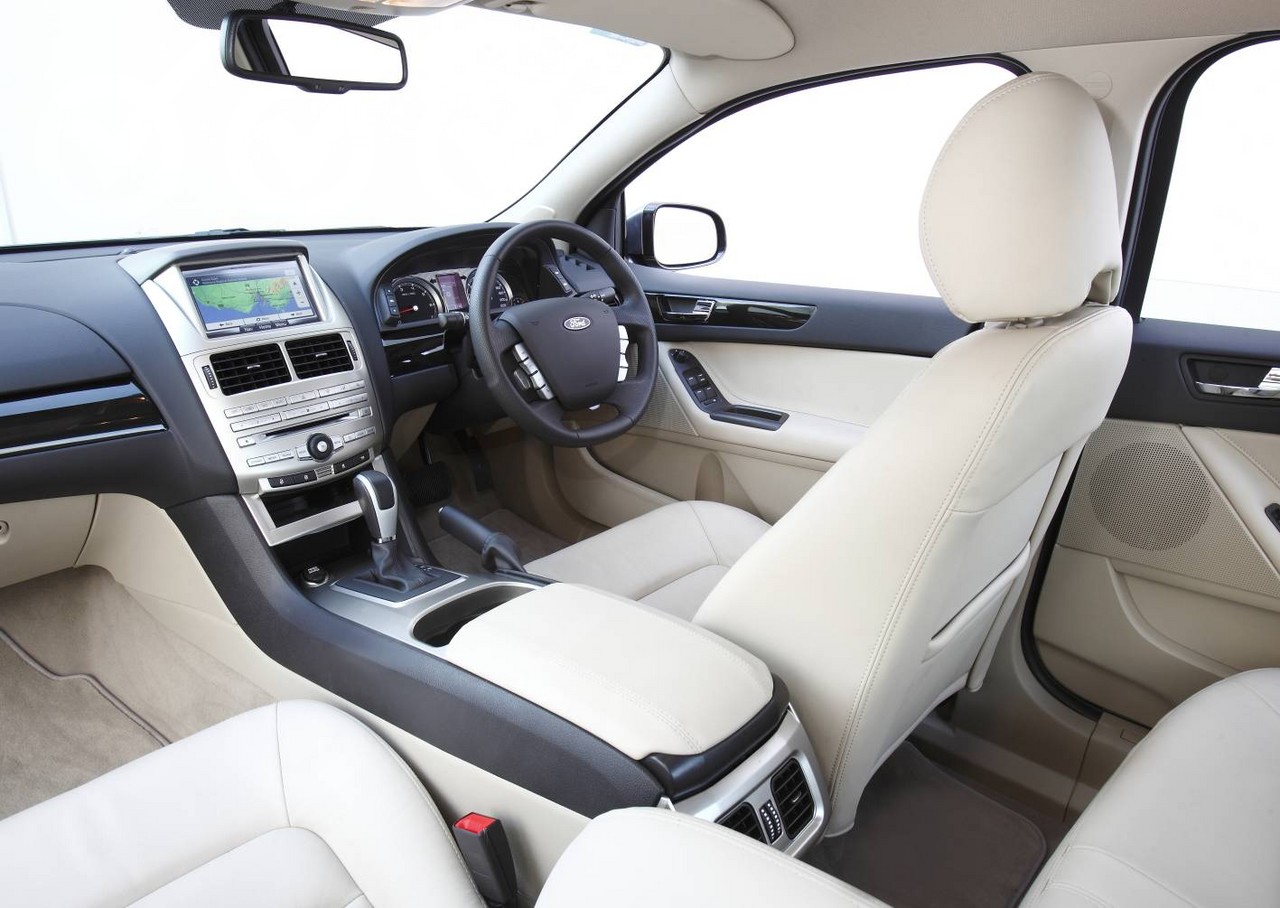
- Impressive ride/handling balance
- Powerful XR6 Turbo and XR8 engines
- Economical EcoBoost engines are a well-kept secret
- Accurate, well-weighted steering provides good feedback
- Spacious interior
- Compromised driving position
- Disappointing interior plastics
- Cast-iron 4.0-litre engines are heavy and not fuel-efficient
- Coolant lines for automatic transmission cooler susceptible to failure
- For five-speed 5R55N/S transmission, reports of bands snapping and overdrive planetary gear set failure
- ‘Control Blade’ semi-trailing arm rear suspension inferior to VE Commodore-based four-link IRS, particularly for high-powered applications
Review: Ford FG.I Falcon (2008-11)
Overview
Released in May 2008, the Ford FG Mark I (FG.I) Falcon was a large, rear-wheel drive sedan – unlike previous Falcon generations, wagon models were not produced and the BF wagon continued to be produced until 2010. Manufactured in Campbellfield, Victoria, the FG Falcon was initially available with naturally aspirated and turbocharged 4.0-litre inline six cylinder petrol engines, 4.0-litre six cylinder LPG engines and 5.4-litre V8 engines. The 4.0-litre LPG and 5.4-litre V8 petrol engines were discontinued in 2010, while a 4.0-litre ‘EcoLPi’ dedicated LPG engine was released in July 2011.
Shown in the table below, the FG Falcon range consisted of three variant classes: the base XT, the sporty XR range (XR6, XR6 Turbo and XR8) and the G-Series (G6, G6E and G6E Turbo).
Engines: Barra 195, Barra 270T, E-Gas, EcoLPi and Boss 290
Of the engines,
- The 4.0-litre Barra 195 inline six-cylinder petrol engine had a cast iron block, a cast aluminium cylinder head, double overhead camshafts (DOHC, simplex chain-driven), dual independent variable camshaft timing, four valves per cylinder, Duratec-style finger followers, a dual resonance inlet manifold, coil-on-plug ignition, electronic throttle control, exhaust gas recirculation, twin knock sensors and a compression ratio of 10.3:1. Compared to its Barra 190 predecessor, changes for the Barra 195 engine included
- A new ‘fast-burn’ cylinder head which used revised intake port profiling and combustion chamber geometry to increase the swirl of the incoming fuel/air charge for a quicker rate of combustion; and,
- A new dual-mode, split plenum composite intake manifold with a new electronic throttle body and fuel rail assembly;
- For the Falcon XR6 Turbo, the Barra 270T engine added a Garrett GT3576R turbocharger which had engine oil-lubricated and water-cooled bearings, an air-to-air intercooler and an electronic single bypass wastegate. The turbocharger was mounted off a cast stainless steel exhaust manifold and provided maximum boost pressure of 7 psi (10 bar). Compared to the Barra 195 engine , the Barra 270T engine had ‘dished bowl’ shaped pistons, more temperature tolerant exhaust valves and increased fuel pressure (4.0 bar, compared to 2.4 bar). Relative to its Barra 245T predecessor, introduced
- A ‘fast-burn’ cylinder head (described above);
- A new GT3576R turbocharger which provided boost pressure 30 per cent faster;
- A new intercooler – with bar and plate construction – which was 50 per larger, provided a 40 per cent improvement in heat rejection and a 34 per cent reduction in air low restriction;
- A new single runner intake manifold;
- A new exhaust manifold which provided a 14 per cent reduction in flow restriction;
- An increased compression ratio 8.8:1 (previously 8.7:1);
- Two cam timing strategies: 1) a primary VCT strategy which balanced maximum power with fuel efficiency, and 2) a secondary strategy which optimised turbocharger response for wide open throttle acceleration events; and,
- A transient overboost function which enabled the engine to increase boost pressure by up to 10 per cent for several seconds.
- Compared to the Barra 195 engine, the 4.0-litre Barra E-Gas dedicated LPG engine had a Vialle closed-loop single-point carburetion system, stronger connecting rods, a compression ratio of 10.3:1 and hardened valves and valve seats. For the FG range, the E-Gas engine had new inlet and exhaust systems, a re-tuned throttle map and optimised engine calibrations;
- Released in July 2011, the 4.0-litre Barra EcoLPi engine had liquid-phase LPG injection whereby liquid LPG was injected directly into the intake port. Compared to its E-Gas predecessor, changes for the EcoLPi engine included a new high-pressure rail and injectors, new lightweight pistons, a 12.0:1 compression ratio, new polymer fuel lines, fuel line and in-tank filters, fuel tank internals, high-pressure fuel pump, catalytic converter (now shared with the Barra 195 engine) and fuel priming strategy;
- For the Falcon XR8, the 5.4-litre Boss 290 V8 engine was assembled by hand in Campbellfield and had a cast iron block, a cast aluminium alloy cylinder head, high compression pistons with domed tops, sintered conrods, a forged steel crankshaft, double overhead camshafts, roller finger followers, four valves per cylinder, a 75 mm throttle body with drive-by-wire linkage and a compression ratio of 10.5:1. Compared to the Boss 260 V8 engine , the Boss 290 engine had high-lift inlet and exhaust camshafts that increased valve lift to 13 mm and 12 mm, respectively (compared to 10 mm and 10 mm in the Boss 260) for improved inlet flow and exhaust gas clearance.
In June 2010, a new catalytic converter was introduced and the powertrain control module (PCM) had new calibrations for Euro IV emissions compliance.
Transmissions
The FG Falcon was available with the following transmissions:
- for the E-Gas engine, the four-speed 93-4AT automatic transmission;
- for the 4.0-litre petrol, Ford’s five-speed 5R55S automatic transmission or six-speed ZF 6HP26 automatic transmission (the latter standard from June 2010);
- for the EcoLPi engine, the six-speed ZF 6HP26 automatic transmission; and,
- for the Barra 270T and Boss 290 engines, six-speed Tremec TR6060 manual or six-speed ZF 6HP26 automatic transmissions.
The ZF 6HP26 transmission was available in two versions: a standard version with a torque capacity of 450 Nm and a high-performance 600 Nm version (for use with the Barra 270T and Boss 290 engines) which had upgraded clutches with extra plates in the clutch packs. For the Barra 270T and Boss 290 engines, the 6HP26 transmission had a cylinder cut function whereby the fuel injectors would be deactivated during gearshifts to reduce shift times and better control turbo boost pressure during gearshifts.
Development and dimensions
In addition to powertrain changes, the FG Falcon introduced the following developments:
- A stronger body structure which made increased use of high-strength steels and ultra high-strength Boron steel and included a new front subframe, additional reinforcement inside the front rails, new high strength floor cross members, transmission tunnel reinforcement and a larger, stronger B-pillar;
- New Virtual Pivot Control Link front suspension (described below);
- A forward-mounted, Y-shaped steering rack with variable-ratio steering gear;
- Upgraded static sealing and triple-sealed doors;
- Redesigned fuel tanks; and,
- A self-adjusting park brake.
Compared to the BF Falcon , the FG Falcon was 39 mm longer (at 4955 mm), 5 mm wider (1869 mm), 9 mm taller (1453 mm) and had a 9 mm longer wheelbase (2838 mm). The FG Falcon had a 535 litre boot when fitted with a temporary spare wheel and 505 litres when fitted with a full-size spare wheel.
Suspension
The FG Falcon’s double wishbone front suspension had two lower ball joints that connected the separate lower arms to the suspension knuckle. These two lower links created a virtual pivot of the lower arm – hence the ‘Virtual Pivot Control Link’ name – and allowed the suspension to behave as though the lower pivot point was at the intersection of the two arms. Due to the use of aluminium and high strength steels, the Virtual Pivot Control Link suspension was 22 kg lighter than that in the BF Falcon.
The independent rear suspension (IRS) had three control arms:
- A forged upper control arm;
- A stamped front lower control arm; and,
- A stamped rear lower control arm.
Each control arm had a cross axis ball joint on the wheel assembly end and was attached to the subframe and knuckle. Furthermore, the ‘Control Blade’ was a stamped trailing arm which provided lateral support and acted as a vertical pivot point.For the FG Falcon, the roll centre height was increased to reduce in-corner roll and improve straight line stability, while toe-angle was revised to improve steering feel and stability.
Both the front and rear suspension included monotube shock absorbers.
| Engine | Variant | Years | Trans. | Peak power | Peak torque |
|---|---|---|---|---|---|
| 4.0-litre Barra E-Gas LPG I6 | XT, G6, G6E, XR6 |
2008-10 | 4sp auto | 156 kW at 4750 rpm | 371 Nm at 2750 rpm |
| 4.0-litre Barra EcoLPi LPG I6 | XT, G6, G6E, XR6 |
2011 | 6sp auto | 198 kW at 5000 rpm | 409 Nm at 3250 rpm |
| 4.0-litre Barra 195 petrol I6 | XT, G6 |
2008-10 | 5sp auto | 195 kW at 6000 rpm* | 391 Nm at 3250 rpm* |
| 2008-11 | 6sp auto | ||||
| G6E | 2008-11 | 6sp auto | |||
| XR6 | 2008-10 | 5sp auto | |||
| 2008-11 | 6sp man, 6sp auto |
||||
| 4.0-litre Barra 270T turbo petrol I6 | G6E Turbo | 2008-11 | 6sp auto | 270 kW at 5250 rpm | 533 Nm at 2000 rpm** |
| XR6 Turbo | 2008-11 | 6sp man., 6sp auto |
|||
| 5.4-litre Boss 290 petrol V8 | XR8 | 2009-10 | 6sp man., 6sp auto |
290 kW at 5750 rpm | 520 Nm at 4750 rpm |
**Peak torque of 586 Nm available with overboost.
Safety equipment
With the exception of the E-Gas LPG models, standard safety equipment for the Ford FG Falcon included dual front airbags, front side head/thorax airbags, electronic stability control, traction control, ABS, electronic brake force distribution, brake assist and front seatbelt pretensioners; the G6E and G6E Turbo were also fitted with full-length curtain airbags, while the front side head/thorax airbags were replaced with thorax-only airbags. The E-Gas LPG models initially omitted electronic stability control, traction control and brake assist, though these items were fitted as standard from May 2009.
Brakes
The standard braking package for the FG Falcon consisted of 298 mm by 28 mm vented front brake discs with twin-piston callipers rotors and 303 mm by 16 mm solid rear discs with single piston callipers. However, the XR8, XR6 Turbo and G6E Turbo variants were fitted with a premium braking package which had 322 mm by 28 mm vented front brake discs and 328 mm by 26 mm vented rear discs.
ANCAP crash testing
In ANCAP crash testing , a 2008 FG Falcon XT received a five star adult occupant protection rating with a score of 34.61 out of 37; the E-Gas models, however, were given a four star rating until they were fitted with electronic stability control in May 2009. In the offset crash test, there was a slight risk of serious chest and leg injury. In the side impact and pole tests, however, maximum points were awarded.
Features: Falcon XT
Standard features for the Ford FG Falcon XT included 16-inch steel wheels with Goodyear Eagle Excellence 215/60 R16 tyres, a four speaker sound system with a CD player, auxiliary input and MP3-compatibility, climate control air conditioning, a four-way power adjustable driver’s seat (with manual lumbar adjustment), cruise control, automatic headlights, 60/40 split and folding rear seats, a multifunction steering wheel, remote central locking, power windows and mirrors, a height and reach adjustable steering column, trip computer and an immobiliser.
From September 2008, the Falcon XT was fitted with 16-inch alloy wheels as standard. From June 2010; Bluetooth and iPod connectivity were fitted as standard.
Features: Falcon XR6, XR6 Turbo and XR8
Compared to the Falcon XT, Falcon XR6 added 17-inch alloy wheels with Dunlop SP Sport 01A 245/45 R17 tyres, front fog lamps, sports seats, sports instrument cluster and alloy pedal covers.
The XR6 Turbo and XR8 were also fitted with 18-inch alloy wheels with Dunlop SP Sport Maxx 245/40 R18 tyres, upgraded front brakes and a limited slip differential.
For the XR6 Turbo, the Tremec TR6060 transmission had a launch assist function which could be activated when the vehicle was stationary, with the clutch fully disengaged and the accelerator applied. After 2-3 seconds, the turbo would spool up with 80 per cent cool air that was pumped by deactivated cylinders. Once the clutch was released and the vehicle began to move, all cylinders would be reactivated. The launch assist function provided more consistent launch acceleration, reduced turbo and exhaust temperatures, and minimised turbo lag and clutch wear.
Furthermore, the XR8 had a Semi Active Muffler (SAM) which consisted of a cylindrical valve mounted that was mounted on the muffler end-plate and extended inside the intermediate muffler. At 2800 rpm, exhaust gas pressure would cause the spring-loaded valve to open and provide a louder exhaust note.
Features: Falcon G6, G6E and G6E Turbo
Compared to the XT, the Falcon G6 added 17-inch alloy wheels with Goodyear Eagle Excellence 235/50 R17 tyres,’luxury sports’ suspension tune, front fog lamps, suede seat bolsters, rear parking sensors and a rear centre armrest with cupholders.
Beyond this, the Falcon G6E added a nine speaker (including subwoofer) sound system with a six-disc in-dash CD player, dual-zone climate control air conditioning, leather seats, eight-way power adjustable driver’s seat with three position memory, seven-inch TFT Interior Command Centre (ICC) screen, reversing camera, Bluetooth mobile phone integration and an electrochromatic rear vision mirror.
The range-topping Falcon G6E Turbo featured 18-inch alloy wheels with Dunlop SP Sport Maxx 245/40 R18 tyres and iPod integration. Visually, the G6E Turbo could be identified by its bright headlamp bezels with unique exterior elements and a rear lip spoiler.
2009 Falcon G6 Limited Edition
In September 2009, the falcon G6 Limited Edition was released and was distinguished by its full-length curtain airbags, 18-inch alloy wheels (17-inch for LPG models), leather-detailed seat trim, a leather-wrapped steering wheel with satin alloy audio and cruise control buttons, iPod integration and Bluetooth mobile phone integration. The G6 Limited Edition returned in February 2010.
2010 Falcon G6 50th Anniversary
In July 2010, Falcon G6 50th Anniversary editions were released. Compared to the standard G6, the 50th Anniversary edition featured 19-inch ten-spoke alloy wheels, satellite navigation system with SUNA Traffic Channel, leather detailed seat trim with embroidered ’50th Anniversary’ logos and ’50th Anniversary’ floor mats. Inside, there was also special interior trim for the centre console, instrument panel and front door spears. Visually, the G6 50th Anniversary edition could be identified by its ‘Medium Stealth’ upper and lower grille accents, ‘Light Stealth’ accents for the foglight bezels and alloy wheels and ’50th Anniversary’ badging.
2010 Falcon XR6 and XR6 Turbo 50th Anniversary
In July 2010, 50th Anniversary editions of the Falcon XR6 and XR6 Turbo were released. These 50th Anniversary editions featured a nine speaker (including subwoofer) sound system with a six-disc in-dash CD player and a leather-wrapped sports steering wheel; XR6 variants also had 18-inch alloy wheels and partial leather seat trim, while the XR6 Turbo had 19-inch alloy wheels, leather detailed seat trim and rear parking sensors. Inside, there were embroidered XR50 logos on the seats, XR50 carpet mats and door scuff plates, ’50th Anniversary’ instrument cluster graphics and special interior trim for the centre console, instrument panel and front door spears.
Visually, the 50th Anniversary editions could be identified by their XR50 body stripes, ‘Dark Stealth’ colour accents on the upper and lower grilles, fog light bezels and rear bumper insert, ‘Medium Stealth’ accents on the alloy wheels, door mirrors with integrated indicator lights and G6 tail-lights.
2011 Falcon XR6 Limited Edition
In August 2011, the Falcon XR6 Limited Edition was released; it was distinguished by its 18-inch alloy wheels, leather trim sports seats, a seven-inch multi-function display and rear parking sensors. Visually, the XR6 Limited Edition could be identified by its ‘Limited Edition’ badging and colour-accented grille and fog light surrounds.
Brochures
- Brochure: Ford FG.I Falcon (August 2008)
- Brochure: Ford FG.I Falcon (July 2009)
- Brochure: Ford FG.I Falcon (October 2010)
Related links
- Ford Newsroom: FG Falcon – Model by Model feature walk (April 2008)
- Ford Newsroom: Class-Leading Space in FG Falcon (April 2008)
- Ford Newsroom: FG Falcon – A Model of Refinement (April 2008)
- Ford Newsroom: FG Falcon: Taking Safety to New Levels (April 2008)
- Ford Newsroom: Falcon Asserts Dynamics Dominance (April 2008)
- Ford Newsroom: More Performance and Improved Fuel Economy (April 2008)
- Ford Newsroom: FG Falcon – Performance, Responsiveness and Fuel Efficiency (April 2008)
- Ford Newsroom: FG Falcon – The Latest in Integrating Vehicle Systems (April 2008)
- Ford Newsroom: FG Falcon – Comfort, Style and Technology (April 2008)
- Ford Newsroom: Ford Improves Fuel Economy and Safety on FG Falcon (April 2009)
- Ford Newsroom: Ford Introduces Value-Packed G6 Limited Edition (September 2009)
- Ford Newsroom: Demand Sparks Return of G6 Limited Edition (February 2010)
- Ford Newsroom: Ford Commemorates 50 Years of Falcon (April 2010)
- Ford Newsroom: EcoLPi Falcon To Go On Sale Mid-Year (April 2011)
Review: Ford FG.II Falcon (2011-14)
Overview
Released in December 2011, the FG Mark II (FG.II) Falcon introduced additional safety equipment, features and greater refinement, with a thicker inner dash insulator and front floor sound barrier. Visually, the FG.II Falcon could be identified by its new ‘tri-plane’ front end with trapezoidal grille, new bumpers and grille finishes, slim-line upper air intake with wing-form grille blades and a supplementary lower cooling slot. The XR and G-Series models were also fitted with a new lighting package with precision design projector headlights.
Turbocharged ‘EcoBoost’ engine
From April 2012, the FG.II Falcon was available with the 2.0-litre four-cylinder ‘EcoBoost’ turbocharged petrol engine . Manufactured in Spain, the EcoBoost engine had an aluminium block and cylinder head, high-pressure direct petrol injection (operating at 150 bar), a single turbocharger which provided boost pressure up to 13 psi (0.9 bar), double overhead camshafts (chain-driven), twin independent variable cam timing (Ti-VCT), special oil-cooled pistons with optimised bowls, coil on plug ignition, a balance shaft and a compression ratio of 9.3:1.
The EcoBoost engine required 95 RON premium unleaded petrol and was mated to a six-speed ZF 6HP21/X6 automatic transmission. The EcoBoost engine reduced the FG.II Falcon’s kerb weight by 74 kg and suspension changes included a 32 mm front stabiliser bar (previously 31 mm), retuned spring and damper rates, a 13 mm lower ride height for XT variants and a mass damper on the rear axle.
Other changes for EcoBoost models included:
- A variable displacement power steering pump;
- A unique sound insulation package, including an optimised outer dashboard insulation, a thicker inner dashboard insulator, an improved front floor sound barrier and, as previously introduced in the SZ Territory, an ‘acoustic’ windscreen;
- Aerodynamic underbody shields; and,
- For XT variants, 215/60 R16 Goodyear Assurance Fuel Max Low Rolling Resistance tyres (inflated at 38 psi).
| Engine | Variant | Trans. | Peak power | Peak torque |
|---|---|---|---|---|
| 2.0-litre EcoBoost turbo petrol I4 | XT, G6, G6E |
6sp auto | 179 kW at 5500 rpm | 353 Nm at 2000 rpm |
| 4.0-litre Barra EcoLPi LPG I6 | XT, G6, G6E, XR6 |
6sp auto | 198 kW at 5000 rpm | 409 Nm at 3250 rpm |
| 4.0-litre Barra 195 petrol I6 | XT, G6, G6E |
6sp auto | 195 kW at 6000 rpm | 391 Nm at 3250 rpm |
| XR6 | 6sp man., 6sp auto |
|||
| 4.0-litre Barra 270T turbo petrol I6 | G6E Turbo | 6sp auto | 270 kW at 5250 rpm | 533 Nm at 2000 rpm |
| XR6 Turbo | 6sp man., 6sp auto |
Safety equipment
Compared to its FG.I predecessor, standard safety equipment was extended to include full-length curtain airbags; the FG.II Falcon was also fitted with a ‘Generation 9.0’ electronic stability control system.
Features
Standard features for the FG.II Falcon were extended to include a USB audio input (with MP3-compatibility). Furthermore, all variants other than the Falcon XT were to be fitted with a new Interior Command Centre (ICC) which had an 8.0-inch colour touch-screen multimedia interface. For the G6E and G6E Turbo, the touch-screen featured an integrated satellite navigation system with Traffic Message Channel (TMC).
2012 Falcon G6 Limited Edition
In July 2012, the Falcon G6 Limited Edition was released. Compared to the standard G6, the G6 Limited Edition added leather seat trim, contoured front sports seats, a reversing camera and carpet mats. Visually, the G6 Limited Edition could be identified by its unique 17-inch alloy wheels, rear lip spoiler, ‘Limited Edition’ badging and colour accents for the front grille and fog light surrounds.
Brochures
- Brochure: Ford FG.II Falcon (August 2011)
- Brochure: Ford FG.II Falcon (December 2012)
- Brochure: Ford FG.II Falcon (August 2013)
Related links
- Specifications: Ford FG.II Falcon (September 2012)
- Ford Newsroom: Ford Unveils New Smart Design FG Falcon MkII (September 2011)
- Ford Newsroom: Falcon EcoBoost Engineered for Australia (April 2012)
- Wikipedia.org: Ford FG Falcon
